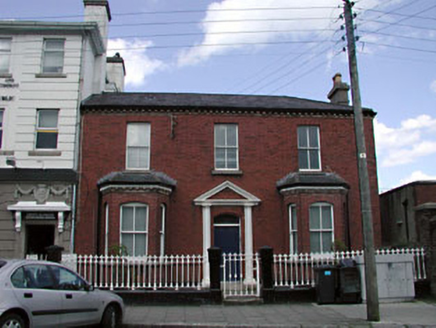Survey Data
Reg No
11818027
Rating
Regional
Categories of Special Interest
Architectural, Artistic
Original Use
House
In Use As
Unknown
Date
1860 - 1870
Coordinates
280379, 215099
Date Recorded
17/02/2003
Date Updated
--/--/--
Description
End-of-terrace three-bay two-storey red brick house, c.1865, on a symmetrical plan retaining original fenestration with segmental-headed door opening to centre having single-bay single-storey flanking canted bay windows. Renovated, c.1985. Hipped and gable-ended roof with slate. Clay ridge tiles. Rendered chimney stack. Cast-iron rainwater goods on profiled yellow brick eaves course. Red brick Flemish bond wall to front (south-west) elevation. Yellow brick dentilated course to eaves. Rendered walls to remainder. Ruled and lined. Unpainted. Segmental-headed window openings to canted bay windows. Square-headed window openings to first floor. Stone sills. Original 2/2 timber sash windows. Segmental-headed door opening. Rendered engaged columnar doorcase added, c.1985, with moulded rendered pediment over. Timber panelled door. Overlight. Set back from line of road. Sections of cast-iron railings to forecourt on rendered plinth walls with decorative finials, rendered piers having chamfered corners and cast-iron gate.
Appraisal
This house, the present use of which is uncertain, is an attractive symmetrically-planned block of graceful proportions that has been well maintained to present an almost-intact original aspect. The house is of social and historical significance, representing a component of the development and expansion of the historic core of Newbridge in the mid nineteenth century. The house is distinguished by the construction entirely in red brick with discrete yellow brick dressings, which attests to the technological advances that allowed for the mass-production of economic building materials. The house retains many important original salient features and materials, including timber fittings to the door, timber sash fenestration and a slate roof having cast-iron rainwater goods. Of some artistic interest are the decorative railings to the forecourt, which are good examples of early surviving cast-iron work.

